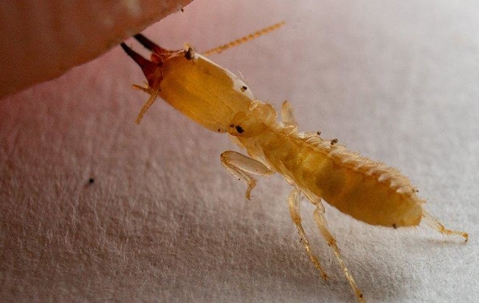Termites are invasive insects that live underground in huge colonies and get the nutrients they need from eating cellulose. For a homeowner, a termite infestation can be a literal nightmare. Termites tunnel into a home's wooden structure, weakening it and causing thousands of dollars in damages.
There are over 2700 species of termites, but in South Carolina, you're likely to run into the following species:
- Subterranean termites grow to 1/8 of an inch long and have long, oval-shaped bodies that are usually creamy white to black. Subterranean termites live in underground colonies and build mud tubes to travel through without drying out.
- Formosan termites are one of the largest, growing up to a 1/2 an inch long. Formosan termites are creamy white to brown and have long, narrow bodies. This species is the most aggressive and usually invades homes through mud tubes constructed from soil to the nearest wood.
- Drywood termites are the largest common termite species in the United States. Drywood termites grow up to 1 inch in length. Their bodies are long and narrow, ranging from creamy white to light brown.
Any termite species can pose a threat, but drywood termites take their name specifically from their preference for dry wood, making them one of the most dangerous to the structure of your home.
Let's learn more about the damage termites can cause, signs of termites inside your house, and how to find reliable pest control in North Augusta.
The Life Cycle Of A Termite Colony
Termites in North Augusta live in huge colonies, sometimes reaching over half a million members, and split the responsibilities of providing and maintaining the colony between different castes.
A termite starts its life as a termite egg laid by the queen. A queen can produce over a thousand eggs each day. Once the egg hatches, it becomes larvae and, over the next couple of weeks, grows into a reproductive, worker, or soldier termite.
Worker termites are immature termites that do most of the upkeep of the colony, gather food, and protect the queen and the young.
Soldier termites protect the colony from invaders, usually other insects.
Reproductives, also called swarmers because they swarm from the nest, are the most visible part of the hive. You'll see these termites flying around, looking for a place to start a colony.
Swarmers can also become a secondary queen or even replace the queen if needed.
The Extent Of Damage Termites Can Silently Create To Your Home
A big problem with termite infestations is that you'll rarely catch them in their early stages. By the time they are spotted and dealt with, they've generally already done significant damage.
In as little as six months, termites can cause significant structural damage to the frame of your house or have already chewed their way through electrical wiring insulation, causing fires and electrical outages.
How To Remove Factors That Attract Termites To Your Home
The best way to deal with a termite infestation is to prevent it from starting in the first place. The following termite prevention tips will help you discourage termites from invading your home:
- Make sure water does not pool around your foundation.
- Take care of any plumbing leaks.
- Make sure crawl spaces and basements are well-ventilated.
- Seal cracks and crevices that swarmers can get in through.
- Make sure any wood in contact with the ground or foundation is properly treated.
Call a termite control professional immediately if you see signs of a termite infestation, such as hollow-sounding wood or bubbling paint!
The Best Way To Protect Your Home From Termites
At Aiken Pest Control, we have been helping South Carolina residents with termite removal and other pest problems for over 50 years. If you suspect a termite infestation, don't wait until you have significant damage; call Aiken Pest Control and schedule a free termite inspection today!

